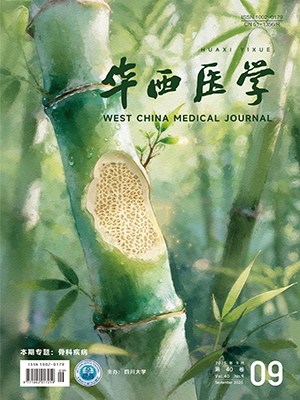| 1. |
Zhou M, Wang H, Zhu J, et al. Cause-specific mortality for 240 causes in China during 1990-2013: a systematic subnational analysis for the Global Burden of Disease Study 2013. Lancet, 2016, 387(10015): 251-272.
|
| 2. |
Wu SM, Wu B, Liu M, et al. Stroke in China: advances and challenges in epidemiology, prevention, and management. Lancet Neurol, 2019, 18(4): 394-405.
|
| 3. |
Wu S, Yuan R, Wang Y, et al. Early prediction of malignant brain edema after ischemic stroke. Stroke, 2018, 49(12): 2918-2927.
|
| 4. |
Liebeskind DS, Jüttler E, Shapovalov Y, et al. Cerebral edema associated with large hemispheric infarction. Stroke, 2019, 50(9): 2619-2625.
|
| 5. |
吳思緲, 吳波, 郭富強, 等. 重癥腦梗死優化診治方案及流程建議草案. 華西醫學, 2019, 34(10): 1096-1108.
|
| 6. |
Serena J, Blanco M, Castellanos M, et al. The prediction of malignant cerebral infarction by molecular brain barrier disruption markers. Stroke, 2005, 36(9): 1921-1926.
|
| 7. |
Rosell A, Cuadrado E, Ortega-Aznar A, et al. MMP-9-positive neutrophil infiltration is associated to blood-brain barrier breakdown and basal lamina type Ⅳ collagen degradation during hemorrhagic transformation after human ischemic stroke. Stroke, 2008, 39(4): 1121-1126.
|
| 8. |
Hallenbeck JM, Dutka AJ, Tanishima T, et al. Polymorphonuclear leukocyte accumulation in brain regions with low blood flow during the early postischemic period. Stroke, 1986, 17(2): 246-253.
|
| 9. |
Peerschke EI, Yin W, Ghebrehiwet B. Complement activation on platelets: implications for vascular inflammation and thrombosis. Mol Immunol, 2010, 47(13,SI): 2170-2175.
|
| 10. |
Zhang Y, Liu G, Wang Y, et al. Procalcitonin as a biomarker for malignant cerebral edema in massive cerebral infarction. Sci Rep, 2018, 8(1): 993.
|
| 11. |
Kasner SE, Demchuk AM, Berrouschot J, et al. Predictors of fatal brain edema in massive hemispheric ischemic stroke. Stroke, 2001, 32(9): 2117-2123.
|
| 12. |
中華醫學會神經病學分會, 中華醫學會神經病學分會腦血管病學組. 中國急性缺血性腦卒中診治指南 2014. 中華神經科雜志, 2015, 48(4): 246-257.
|
| 13. |
Emsley HC, Tyrrell PJ. Inflammation and infection in clinical stroke. J Cereb Blood Flow Metab, 2002, 22(12): 1399-1419.
|
| 14. |
Whiteley W, Jackson C, Lewis S, et al. Association of circulating inflammatory markers with recurrent vascular events after stroke: a prospective cohort study. Stroke, 2011, 42(1): 10-16.
|
| 15. |
Moldes O, Sobrino T, Millán M, et al. High serum levels of endothelin-1 predict severe cerebral edema in patients with acute ischemic stroke treated with t-PA. Stroke, 2008, 39(7): 2006-2010.
|
| 16. |
Ibrahim F, Menezes S, Buhnerkempe M, et al. systemic white blood cell count as a biomarker for malignant cerebral edema in large vessel ischemic MCA stroke. J Stroke Cerebrovasc Dis, 2022, 31: 106550.
|
| 17. |
符少萍, 王彤. 急性腦卒中外周血白細胞的臨床觀察. 新醫學, 1998(增刊 2): 62-63.
|
| 18. |
Ritter LS, Orozco JA, Coull BM, et al. Leukocyte accumulation and hemodynamic changes in the cerebral microcirculation during early reperfusion after stroke. Stroke, 2000, 31(5): 1153-1161.
|
| 19. |
Nagaraja D, Christopher R, Tripathi M, et al. Preceding infection as a risk factor of stroke in the young. J Assoc Physicians India, 1999, 47(7): 673-675.
|
| 20. |
Ka?mierski R, Guzik P, Ambrosius W, et al. Leukocytosis in the first day of acute ischemic stroke as a prognostic factor of disease progression. Wiadomosci lekarskie, 2001, 54: 143-151.
|
| 21. |
Vogelgesang A, Grunwald U, Langner S, et al. Analysis of lymphocyte subsets in patients with stroke and their influence on infection after stroke. Stroke, 2008, 39(1): 237-241.
|
| 22. |
方媛. 腦卒中急性期血糖變化及其與預后的關系. 成都: 四川大學, 2006.
|
| 23. |
Christensen H, Boysen G. Blood glucose increases early after stroke onset: a study on serial measurements of blood glucose in acute stroke. Eur J Neurol, 2002, 9(3): 297-301.
|
| 24. |
Bielewicz J, Kurzepa J, Czekajska-Chehab E, et al. Worse neurological state during acute ischemic stroke is associated with a decrease in serum albumin levels. J Mol Neurosci, 2016, 58(4): 493-496.
|
| 25. |
Alvarez-Perez FJ, Castelo-Branco M, Alvarez-Sabin J. Usefulness of measurement of fibrinogen, D-dimer, D-dimer/fibrinogen ratio, C reactive protein and erythrocyte sedimentation rate to assess the pathophysiology and mechanism of ischaemic stroke. J Neurol Neurosurg Psychiatry, 2011, 82(9): 986-992.
|
| 26. |
Acharya P, Jakobleff WA, Forest SJ, et al. Fibrinogen albumin ratio and ischemic stroke during venoarterial extracorporeal membrane oxygenation. ASAIO J, 2020, 66(3): 277-282.
|




